11 Space Systems Modeling and Simulation [Diebold]
PURVIEW
Various industries, from business to engineering to the military, use the concepts of modeling and simulations for multiple applications. Regardless of the use case, modeling and simulation strive to predict the results of an actual event, accounting for all the potential variables and performance parameters, to improve the likelihood of success during execution.
This chapter seeks to 1. describe the history and value of modeling and simulation in the context of modern aerospace and national defense challenges, 2. provide current techniques and toolsets that apply modeling and simulations, 3. and describe the use cases for leveraging these techniques.
LEARNING OBJECTIVES
- Students will understand the criticality of aerospace systems modeling and simulations in the context of modern threats and multi-domain operations.
- Students will have a working knowledge of the inputs that contribute to building a space model and methods for simulating space threats.
- Students will understand the use cases for modeling and simulation for commercial and defense purposes.
KEY TAKEAWAYS
- Modeling and simulation of a space shuttle’s flight or a satellite’s orbit are inherently different from aviation because, in most cases, a spacecraft cannot be recalled and must be validated across the totality of its operational mission before the first launch attempt.
- The use of space for civil, commercial, and military purposes has expanded exponentially since the 1960s, with over 4,000 operational satellites and estimated hundreds more pieces of debris in orbit today flying at thousands of km/h. The advent of intercontinental, hypersonic, and anti-satellite weapons further complicated operations in space, which the US now interprets as a warfighting domain.
- Models and simulations can be categorized by their application (area/environment), resolution level (scale), role (function), and technique. In addition, various computer-based tools are widely available for civil, commercial, and military uses, which augment or replace the legacy tabletop wargaming techniques used to inform decisions about space operations.
INTRODUCTION
Before the advent of computers and automation, military theorists aptly described the enduring characteristics of war and what made great leaders successful in predicting the outcomes of battles. In The Art of War, written approximately 2,500 years ago, Sun Tzu articulated a component of strategy as knowing the enemy and oneself. If you can clearly understand both, you need not fear the result of a hundred battles (Tzu). In the 1800s, Carl von Clausewitz wrote On War, describing probability as one component of the paradoxical trinity. Probability amounts to the fog and friction inherent in combat, comparable to the operational and mission variables[1], as well as chance, accounting for the factors of any given situation that one cannot predict (Clausewitz). In the same period, Baron de Jomini wrote The Art of War, taking a scientific approach by applying critical tenants to the planning and execution of war that would guarantee a commander’s success (Jomini). The latter two theorists built their concepts after observing Napoleon, whom many considered a “military genius” during the rise of nation-states and the French Revolution. Unlike modern military, civilian, and business leaders, Napoleon relied on intellect and aptitude to make decisions, observed as having the gift of coup d’oeil.[2] In other words, he had the ability to see all factors and variables of a battle wholistically in a way that allowed him to make rapid and accurate decisions with near clairvoyance (Clausewitz).
Although each theorist described the timeless principles of war and what made leaders like Napoleon successful, none lived in a period where the prospect of space warfare, computers, or automation was possible. However, their observations collectively highlight the same problems modern modeling and simulations address, which historical military leaders solved with theory, strategy, and intuition. Given a set of resources, an operating space, and unpredictable variables, how can we reliably estimate the outcome of any given space operation?
The modern age of computing and automation made simulations famous when predictions became more than just thoughts in the minds of expert planners, using vast data sets and calculations to rapidly and objectively compute an outcome that humans would never be able to complete. WarGames, the 1983 classic movie where David Lightman (Matthew Broderick) discovers North American Aerospace Defense Command’s (NORAD) War Operation Plan Response (WOPR) supercomputer simulator, fantasizes about the impact of modeling thermonuclear and biotoxic chemical war. WOPR simulated a Soviet Union first-strike nuclear attack against the United States, autonomously triggering a response by US nuclear sites that nearly started World War III. WOPR performed hundreds of simulations with different variables and found no scenario where a ballistic missile-enabled atomic war could be won (Badham, 1983). The fantasy dreamed by Hollywood 40 years ago is now a reality of the 21st century, with the WOPR demonstrating an actual use case of modeling and simulations used by the US military. Today, dozens of modeling software programs and fully customized simulators for aerospace purposes are widely accessible and, in some cases, made secretly for national defense. Although supercomputers are necessary for some simulations, depending on the precision and accuracy required, devices as small as a smartphone or a tablet computer now have the computational power to get results for various use cases. Before attempting to understand the “what” and “how,” it is essential to know why space modeling and simulations are critical in modern aerospace challenges.
SPACE LAUNCH HISTORY AND CONTEXT
The National Aeronautics and Space Administration (NASA) opened on October 1, 1958, with aspirations to achieve President Kennedy’s objective of completing the first human trip to the moon in the 1960s. NASA accomplished this goal with the Apollo 11 mission in July 1969 and subsequently expanded the mission with five more successful moon landings through 1972 (NASA, 2018). However, none of NASA’s early successes in the Mercury (1958-1963), Gemini (1962-1966), and Apollo (1961-1972) programs could have been possible without extensive modeling and simulations of the first spaceflights before they launched. In 1973, Carroll H. “Pete” Woodling, Chief of NASA’s Crew Training and Simulation Division from 1972-1974 (NASA, 2000), published an experience report of the simulations of manned space flight for crew training. He defined a simulator as a “complex set of hardware (including computers, visual display systems, and simulated crew stations) that presents, with a high degree of accuracy, the total flight characteristics of the actual spacecraft and mission.” In the years leading up to Mercury, Gemini, and Apollo program launches, flight crews spent one-third or more of their total training time in simulations, such as the Command Module Simulator depicted in Figure 11-1. During this period, mission simulators dominated much of the total simulation time, growing from 53% to 67% to 80% across the Mercury, Gemini, and Apollo programs. The 59 crew members in these programs spent 38,261 hours (~4.37 years) conducting simulations before their space missions between 1958 and 1972 (See Figure 11-2) (Woodling, et al., 1973).
Figure 11-1: Apollo Program Command Module Simulator
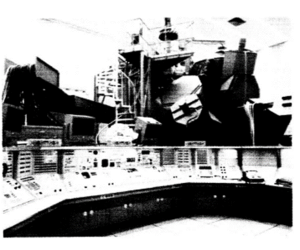
Source: (Woodling, et al., 1973)
Figure 11-2: Simulator Use for Flight Crew Training
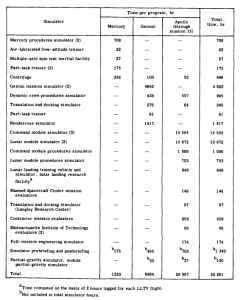
Source: (NASA TN D-7122)
The success or failure of space missions and the crew’s safety relies more on modeling and simulation than any type of aviation operation. The nature of space flight, both in the 1960s and today, is unique in that the vehicle is fully committed at lift-off or launch to the entire mission, experiencing a broad range of mission variables during extended operational timelines. There is no immediate ability to recall vehicles launched into space, like cruise, ballistic, hypersonic missiles, torpedoes, and many unmanned vehicle operations in denied areas (FCNL Education Fund, 2021). Space flight is starkly different from manned aviation where aircraft and crew members are trained and evaluated through live environment flights to validate proficiency and capability gradually. Space vehicles and their crew members must be prepared, proficient, and validated on the entirety of the mission, accounting for all potential flight variables and contingencies before the first launch attempt. After analyzing all of NASA’s earliest space endeavors, Woodling noted the use of comprehensive, high-fidelity simulators as a firm requirement in future space programs (Woodling, et al., 1973).
The wide use of modeling and simulation is essential moving into the 21st century as space flight becomes increasingly commonplace. Although sources differ on the number of successful space missions, there were more space launches in 2022 than in any other year. The Center for Strategic and International Studies (CSIS) reported 182, a 29% increase over 2021 (See Figure 11-3) (CSIS, 2023). Space-based capabilities are also becoming increasingly ubiquitous in everyday life as the cost of commercial space use decreases, and private companies take the lead. Following the retirement of the US space shuttle program, the US government had to rely on other national and commercial launch providers to move goods and astronauts to the international space station. New micro and nanosat technology facilitated the development of small satellites at low cost, which drove the increase in commercially licensed space launches by 100% between 2016 and 2018, primarily in the Low Earth Orbit (LEO) category. As of 2020, approximately 2,000 active satellites were orbiting Earth with 1,300 in LEO, 75 in Medium-Earth Orbit (MEO) (primarily for global navigation services), and 430 in Geosynchronous-Earth Orbit (GEO) (most often used for telecommunications and weather) with 2021 breaking a trend by adding over 1,400 satellites in a single year (International Trade Administration, n.d.) (Chakrabarti, 2021) (NASA, 2009). Some sources place the total number of satellites in orbit today at well over 4,000, with 75 countries owning at least one satellite, over 60% of the total attributed to the US, and SpaceX being the largest private company owner responsible for over 43% of active satellites (See Figure 11-4) (ESRI, 2022). In addition to the commercial satellite space, SpaceX’s Inspiration4 made history on September 15, 2021, as the first all-civilian space mission to launch into Earth’s orbit, following two successful sub-orbital space flights by Virgin Galactic’s Unity 22 and Blue Origin’s New Shepard (Howell, 2021). Although science and technology have improved the capability to launch satellites dramatically since Sputnik (the first satellite launched into Earth’s orbit on October 4, 1957), the number of players, time constraints, weather, and space obstacle variables have increased concurrently, placing a more significant burden on advanced modeling and simulations to achieve successful space flights. However, civilian space vehicles and satellites are not the only use case for aerospace simulators today. Advanced missile systems and unmanned vehicles developed since the 1940s now require the same precision and accuracy as a rocket flying into space. This represents another modeling and simulation use case applied across the multi-domain operations spectrum.
Figure 11-3: Space Environment: Total Launches by Country from 1957 to 2022
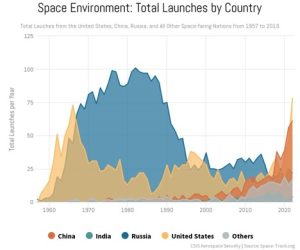
Source:(CSIS Aerospace Security | Space-Track.org)
Figure 11-4: Graphic Representation of All Satellites Orbiting Earth by Country of Ownership
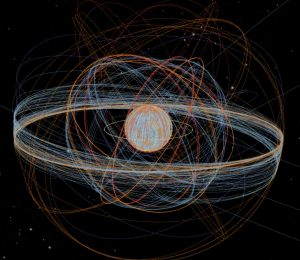
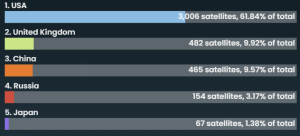
Source: (Satellite Explorer | ESRI)
EVOLVING THREAT CONTEXT
The tools of war have evolved with revolutions in military affairs, providing a temporary asymmetric advantage to the user who had it first. Regarding the use cases for modeling and simulation, none is more significant than the advent of the cruise missile, a low-flying, guided rocket weapon with a low radar cross-section. The German V-1, developed in the early 1940s, is widely understood to be the first cruise missile, and was initially used against London from 1942-1944 (The Editors of Encyclopedia Britannica, 2023). As a precursor to the weapons later developed by the US, Soviet Union, China, and others, the V-1 had a length of 27 ft, carried an 850 kg warhead, flew at 640 km/h, and had an operational range of 250 km (P., 2014). It had limited aerodynamic controls and poor accuracy, with only about 25% reaching its intended targets (University of Florida Department of Mechanical & Aerospace Engineering). Although its characteristics are similar, the lacking range, in-flight controls, and accuracy of the German V-1 are almost incomparable to the most capable cruise and ballistic missiles employed today by the US.
The US’s most prominent operational cruise missile is the Tomahawk (See Figure 11-5), which comes in dozens of variants and can carry both conventional and nuclear payloads. The Tomahawk has been in service since 1983, can carry a 454 kg payload, and range as far as 2,500 km at subsonic speeds or up to 800 km/h depending on the mission and weapon variant.[3] Unlike the V-1, the Tomahawk incorporates a mix of Terrain Contour Matching (TERCOM), Digital Scene Matching Area Correlation (DMAC), and Global Positioning Satellite (GPS) guidance to achieve precision and accuracy, validated through service in the 1991 Gulf War and 2003 Iraq invasion among other conflicts. One of the most public, widely known examples of a mass cruise missile strike was on April 6, 2017, when the US fired 59 Tomahawks against Shayrat Air Base to destroy Syrian forces that conducted a chemical attack against the city of Khan Sheikhoun (See Figures 11-6, 11-7, and 11-8) (CSIS Missile Defense Project, 2023). To execute this attack, each missile had to be individually planned from launch to impact and synchronized in time and space to ensure the mission’s success and limit collateral damage (Eckstein, 2017). This type of operation is only possible with modern modeling of the weapon’s characteristics and a thorough simulation of the missile’s flight against numerous variables, including weather and threat missile defenses. For responsible nation-states seeking to limit collateral damage, the planning, accuracy, and precision requirements for each missile launch only increase as the weapon becomes more deadly.
Figure 11-5: Tomahawk Missile Model
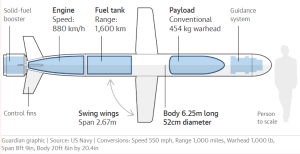
Source: (The Guardian | Credit: US Navy)
Figure 11-6: Image of Sharyat Airfield, Syria
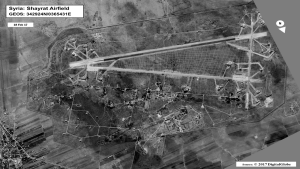
Source: (USNI News | Image Credit: US Department of Defense)
Figure 11-7: Aftermath of 2017 Tomahawk Strike on Shayrat Airfield
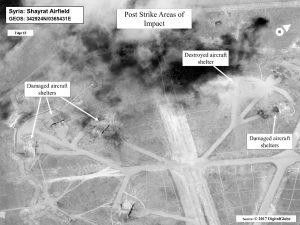
Source: (USNI News | Image Credit: US Department of Defense)
Figure 11-8: Aftermath of 2017 Tomahawk Strike on Shayrat Airfield
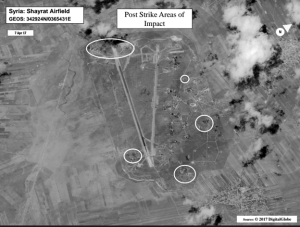
Source: (USNI News | Image Credit: US Department of Defense)
The LGM-30G Minuteman III, which started service in 1970, is a solid-fueled Intercontinental Ballistic Missile (ICBM) and the only remaining land-based component of the US nuclear triad. By the numbers, it has a length of 18.2m, carries either a 335kT (W78) or 300kT (W87) nuclear warhead, and has a range of 13,000km. Although details on the US nuclear triad are limited, available documentation suggests the Minuteman III has a fast launch time (consistent with solid fuel propellant), 100% reliability in testing, and backup launch controllers that make the system more resilient (CSIS Missile Defense Project, 2021). Moreover, the Minuteman III travels on a suborbital trajectory outside Earth’s atmosphere, like the early ICBMs modified for use as launch vehicles for manned orbital missions (Refer to Figure 11-9) (Tate, 2021). Unlike cruise missiles, nuclear weapons have only been used offensively twice in history, during the bombings of Hiroshima and Nagasaki, Japan, by the US on August 6th and 9th, 1944 (History.com Editors, 2022). The “Little Boy” and “Fat Man” bombs were delivered by B-29 aircraft and instantly killed 80,000 and 40,000 people between Hiroshima and Nagasaki, respectively. “Little Boy” and “Fat Man” were deployed over their targets without modern weapons’ precision guidance and accuracy (History.com Editors, 2009).
Imagine a scenario where a Minuteman III is launched from North Dakota, intending to strike Hiroshima over 9,500 km away. In one simulation with the W78 payload, the Minuteman III could cause over 329,000 fatalities and 457,000 injuries at Hiroshima in a single airburst strike, quadrupling the immediate casualty count observed in World War II (Wellerstein, 2022). The impact of a failure or deviation at any point from missile launch to detonation could be catastrophic. Like a spacecraft, there is no ability to recall an ICBM-delivered nuclear weapon and, indeed, no ability to evaluate the exact mission profile before launch. The situation, performance characteristics of the flight, and impact all justify the heavy application of modeling and simulation before ever attempting an ICBM launch to increase the chances of a successful flight and the accuracy of the missile itself. Space-based modeling, concerning ICBMs, is even more important as the prospect of a launch vehicle in orbit capable of delivering a nuclear weapon to any point on Earth becomes a reality.
Figure 11-9: How it Works – Intercontinental Ballistic Missile
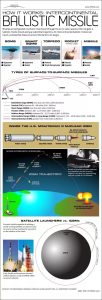
(Sources: Image Credit: Karl Tate/Space.com)
Hypersonic weapons further complicate the modeling and simulation process in both the offensive use of the missile and defense against missile attacks from peer adversaries. Although hypersonic weapons have existed for over 50 years, China, Russia, and the US have made recent progress in the capability to deploy these missiles for reliable, sustained flight (Watts, Trotti, & Massa, 2020). There are two basic categories of hypersonic weapons. Like ICBMs, Hypersonic Glide Vehicles (HGV) can launch into space using a rocket and orbit the Earth under their momentum or travel at suborbital speeds before re-entry and maneuvering through the atmosphere. HGVs are sometimes called hypersonic boost-glide weapons when combined with their rocket booster. The second category is the Hypersonic Cruise Missile (HCM), which is powered by a high-speed, air-breathing engine after acquiring its target (Congressional Research Service, 2023). HCMs are like other cruise missiles in their ability to maneuver throughout flight rather than following a specific trajectory, but differ from other missile types in their speed, traveling between Mach 5 and 25 for an entire flight if required. Refer to Figures 11-10 and 11-11 for a graphic comparison of hypersonic, cruise, and ballistic missiles. Modern hypersonic weapons can capture the best characteristics of both ICBMs and cruise missiles by adding speed and the ability to maneuver for an entire flight, forming a hybrid of existing model classifications (Brockmann & Schiller, 2022). The US Army, with cross-service participation, plans to integrate these new classifications of hypersonic missiles into the 1st Multi-Domain Task Force (MDTF) in 2023, forming a battery within the Strategic Fires Battalion (Congressional Research Service, 2023). See Figure 11-12 for a depiction of a generic MDTF structure. In concept, these weapons will be commanded through the Army’s Advanced Field Artillery Tactical Data System (AFATDS) and require unique Transporter-Erector-Launchers (TEL) (Freedberg, 2019). See Figure 11-13 for a picture of the prototype hypersonic weapon delivered to 17th Field Artillery Brigade. Among the multiple reported hypersonic projects on the horizon, the U.S. Air Force has also evaluated the air-launched AGM-183A (See Figure 11-14) with the B-52H since April 2021 (Tingley, 2022). Concurrent with US developments, China and Russia have also built and evaluated capable hypersonic weapons. In mid-2021, China experimented with two hypersonic gliders launched into LEO, traveling partially around the Earth before being released to engage test targets (See Figure 11-15 for a model of the Chinese DF-ZF). These tests differed from the short, suborbital, ballistic flight with which an HGV is typically deployed, demonstrating an intercontinental travel capability (The International Institute for Strategic Studies, 2022). Additionally, Russia has used the Kinzhal hypersonic missile (See Figure 11-16), an air-launched variant deployable by MiG-31 and Su-34 fighters unveiled in 2018, in combat against Ukraine as recently as March 2023 in conjunction with a conventional missile attack (Neuman, 2023). Requirements for planning a hypersonic missile strike in the modeling and simulations space also translate to defending against them, complicating existing homeland defense planning for Aegis Ballistic Missile Defense (BMD), Ground-Based Mid-Course Defense (GMD), and Terminal High Altitude Area Defense (THAAD) systems (GAO, 2022). See Figures 11-17 and 11-18 for graphic depictions of notional, layered missile defense scenarios. See Figure 11-19 for a description of US missile defense system programs.
Figure 11-10: Notional Flight Paths of Hypersonic Boost-Glide Missiles, Ballistic Missiles, and Cruise Missiles
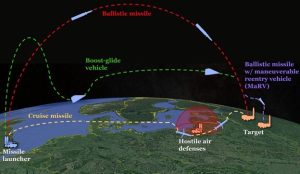
Source: (Breaking Defense | Credit: CSBA)
Figure 11-11: Ballistic vs. Hypersonic Missile Trajectories
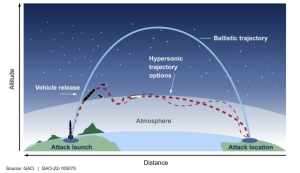
Source: (GAO-22-105075)
Figure 11-12: Notional Generic MDTF
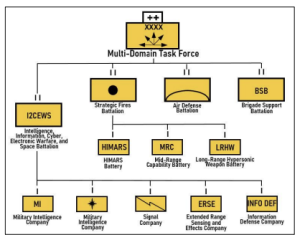
Source: (CRS IF11797 | Credit: Chief of Staff Paper #1 Army Multi-Domain Transformation Ready to Win in Competition and Conflict)
Figure 11-13: The delivery of the prototype hypersonic hardware to soldiers of 5th Battalion, 3rd Field Artillery Regiment, 17th Field Artillery Brigade is completed Oct. 7, 2021, with a ceremony at Joint Base Lewis-McChord, Washington
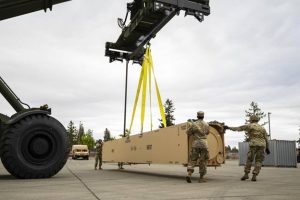
Source: (Defense News | Image Credit: Staff Sgt. Kyle Larsen/U.S. Army)
Figure 11-14: Crew members from the 912th Aircraft Maintenance Squadron secure the AGM-183A Air-launched Rapid Response Weapon Instrumented Measurement Vehicle 2 as it is loaded under the wing of a B-52H Stratofortress during a hypersonic test, Edwards Air Force Base, Calif., Aug. 6, 2020.
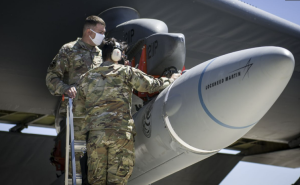
Source: (Space.com | Image Credit: USAF/Giancarlo Casem)
Figure 11-15: Model of Chinese DF-ZF Hypersonic Missile
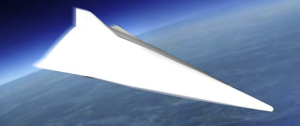
Source: (Atlantic Council | Credit: Wikimedia Commons)
Figure 11-16: Russian Kinzhal Hypersonic Ballistic Missile
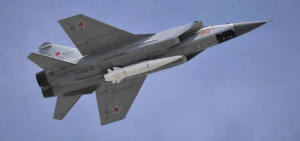
Source: (Atlantic Council | Credit: Wikimedia Commons)
Figure 11-17: Missile Defense Agency’s Hypersonic Efforts in a Notional Scenario
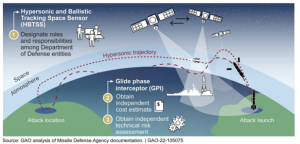
Source: (GAO-22-105075 from analysis of Missile Defense Agency Documentation)
Figure 11-18: Notional Depiction of Layered Homeland Defense
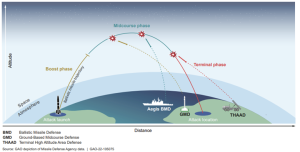
Source: (GAO-22-105075 from Depiction of Missile Defense Agency Data)
Figure 11-19: Description of Missile Defense System (MDS) Programs
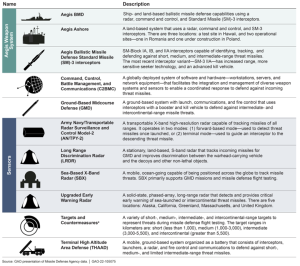
Source: (GAO-22-105075 from Presentation of Missile Defense Agency Data)
Anti-Satellite Weapons (ASAT) present another complex problem for modeling and simulations as their targets orbit at approximately 28,000 km/h in LEO relative to an observer on Earth (National Air and Space Museum, 2017). Although a satellite in LEO travels at the upper end of the high hypersonic regime (Mach 23), orbits are predictable, unlike the flight trajectories of HGVs and HCMs. ASATs come in various weapon platforms, ranging from missiles meant to destroy satellites to lasers and jammers that disrupt them physically. The US built the first ASAT, an air-launched ballistic missile named Blue Orion, in response to the Soviet Union’s launch of Sputnik in 1957 (Blatt, 2020). Over the next 30 years, Cold War competition brought the Soviet co-orbital ASATs that attempted to synchronize their orbits with target satellites before detonating, as well as the US ASM-135, which used a hit-to-kill method exploiting kinetic force alone. The Reagan administration first evaluated the ASM-135 in 1985, demonstrating its capability to destroy an actual satellite in orbit (Blatt, 2020). Since the first successful ASAT tests, China, India, and Russia have researched and expanded their capabilities. Each have recently demonstrated that these weapons remain a threat in the space domain. On January 11th, 2007, China destroyed one of its weather satellites with a modified ballistic missile that created over 3,000 trackable pieces of debris, the largest ever debris field generated by an ASAT (Hadley, 2023). India performed a more carefully planned test on March 27th, 2019, using the Prithvi Delivery Vehicle Mark-II (PDV MK-II) to destroy their own Microsat-R satellite (launched on January 24th, 2019, specifically for this test) in a sun-synchronous orbit at approximately 282 km above the Earth. India’s test only produced about 400 fragments of space debris, most of which would decay naturally in the weeks and months following the test (Tellis, 2019). On November 15th, 2021, Russia used the Nudol PL-19 (See Figure 11-20) anti-ballistic missile interceptor as an ASAT to destroy its own Cosmos 1408 satellite approximately 500 km above the Earth, creating about 1,500 pieces of trackable debris in orbit. The debris from both the Chinese and Russian events still poses a direct threat to astronauts on the International Space Station, who must routinely maneuver their vehicle in orbit to avoid debris and will for many years to come. In the wake of the ongoing Russo-Ukrainian War, Russia has publicly noted the threat of Western satellites aiding Ukraine, such as the Starlink constellation, and has threatened action against US assets in space (Bugos, 2021). Unlike other types of weapon tests conducted on Earth or inside the atmosphere, debris created in space from ASATs is technically challenging to remove and, currently, only occurs through natural degradation. Technical demonstrations such as Japan’s End-of-Life Services by Astroscale Demonstration (ELSA-d) and the ongoing Swiss ClearSpace debris-removing spacecraft planned for launch in 2025 are working towards orbital debris removal capabilities, but are only nascent compared to the scale of the problem (David, 2021) (Skibba, 2021) (Kim, 2021). Although ASATs are not the only cause of space debris, they deliberately induce havoc and could pose an enduring problem through a theoretical phenomenon known as the Kessler Syndrome. In this theory, cascading debris perpetually creates more space junk through subsequent collisions to form debris belts that make orbits unusable (Smith, 2022). The use of ASATs and the corresponding requirement to simulate their effects across all objects orbiting in space is a more complex problem, requiring more advanced models and simulations than any previous contextual example in this chapter. As of this chapter’s writing, China, India, Russia, and the US are the only nations that have conducted an ASAT test. The US is the only of those four who self-imposed a moratorium on testing future direct-ascent ASAT missile systems (Panda & Silverstein, 2022) (Arms Control Association, 2022).
Figure 11-20: The Nudol PL-19 Anti-Ballistic Missile Interceptor
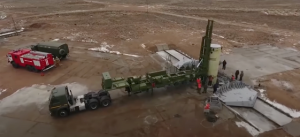
Source: (Arms Control Association | Credit: Russian Ministry of Defense)
Holistically, China and Russia have expanded their total missile, air defense, and space arsenals to incorporate evolving technology described earlier in this chapter as a component of their anti-access area denial networks. China and Russia combine ballistic, cruise, and hypersonic missile technology with survivable and mobile delivery mechanisms that can launch them from the air, land, and sea. The combination of their total missile forces dispersed in orders of battle presents a complex problem for any future war with the ability to threaten any safe haven on Earth (CSIS Missile Defense Project, 2021) (Missile Defense Advocacy Alliance, 2023). See Figures 11-21 and 11-22 for Chinese missile capabilities and Figure 11-23 for Russian land-based missile capabilities.
Figure 11-21: China’s Ballistic & Cruise Missile Capabilities
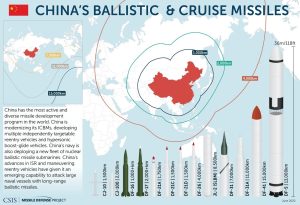
Source: (CSIS Missile Defense Project)
Figure 11-22: China’s Regional Missile Threats
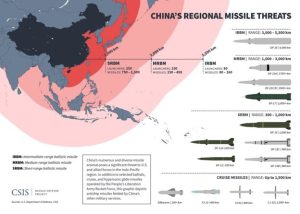
Source: (CSIS Missile Defense Project)
Figure 11-23: Russia’s Land-Based Missile Capabilities
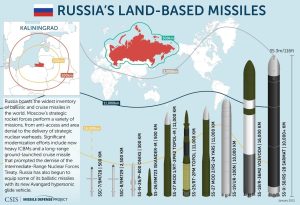
Source: (CSIS Missile Defense Project)
MODELING AND SIMULATION IN DOCTRINE
Strategy and wargames have existed for thousands of years, with the Chinese board game “go” dating back as early as 2356 BCE (The Editors of Encyclopedia Britannica, n.d.). However, recent history suggests that the earliest adaptations of modern wargaming techniques originated from the Prussians, who were, at the time, trying to overcome Napoleon’s advantages. In 1811, Herr von Reisswitz, Prussian War Counselor, invented a wargame that included a terrain table, computations for attrition, technical factors such as range and terrain, and even the issue of chance, which had not previously been used. General Helmuth von Moltke continued the practice while in competition with France once he became Chief of Staff of the Prussian Army (Caffrey, 2000). Wargaming captured what a model-based simulation could not at the time, but that would soon change with additional technology and complexity on the 20th and 21st-century battlefields.
The US Army adopted its current decision methodology, aptly named the Military Decision-Making Process (MDMP), in 1997 with the publication of Field Manual (FM) 101-5, Staff Organization and Operations. MDMP created a single decision-making model from the previous deliberate, combat, and quick models used in the outdated Tactical Decision-Making Process (TDMP). The basic steps in MDMP include 1. Receipt of Mission, 2. Mission Analysis, 3. Course of Action Development, 4. Course of Action Analysis (Wargaming), 5. Course of Action Comparison, 6. Course of Action Approval, and 7. Orders Production (Wampler, Centric, & Salter, 1998). MDMP remains the procedural decision-making tool for tactical-level US Army staff and requires at least a basic application of wargaming to validate that any given course of action meets the criteria of being feasible, acceptable, and suitable. In other words, wargaming validates that the actions a given organization is about to take will achieve the end state intended in an order. Since the 1800s, models, simulations, and wargames have also changed with new operational concepts, especially complicated by adding joint concepts and multiple domains.
US joint warfighting concepts that acknowledged a need for interoperability between multiple domains date back to the War of 1812, when naval operations on Lake Champlain proved decisive in the Army’s land-based campaigns. However, it took 100 years and the aftermath of the Spanish American War for the US military to establish a joint board composed of military leaders in multiple services, including the Army and Navy. Finally, at the end of World War II, the National Security Act of 1947 formally established the Joint Chiefs of Staff, which set conditions for many of the joint concepts and doctrine used today for warfighting (Joint Chiefs of Staff, n.d.).
Over the past 50 years, the US Army underwent five major overhauls in operational concepts, each adapting to the most significant national security challenges of its time. The US Army introduced Active Defense in 1976 on the heels of the Vietnam War as the US shifted its focus to Europe and the threat posed by the Soviet Union. Active Defense echoed more traditional concepts of attrition and terrain-focused warfare forms, remaining separate from the air and maritime operational concepts. As commander of Training and Doctrine Command, General Donn Starry noted the shortcomings in Active Defense that could not address Soviet second-echelon forces and emphasized the need for early interdiction. To tackle the problems with a flexible response to the Soviet Union’s extreme numerical advantage in combat power, the US Army adopted AirLand Battle in 1982. AirLand Battle acknowledged the three-dimensional nature of war, with the land and air warfighting domains as inseparable, capturing the impact of technological advances in modern battles and the fast tempo associated with future wars (Skinner, 1988).
After Desert Storm, the US Army implemented Full Spectrum Operations (FSO) in 2001 and Unified Land Operations (ULO) in 2011 (Granai, 2015) (See Figure 11-24 for a graphic depiction of the ULO operational framework). Both operational concepts incorporated offense, defense, and stability, but they viewed warfighting domains differently than AirLand Battle. Although Space Command was first introduced in 1985, FSO was the first Army operational concept to characterize battlespaces in the air, land, sea, and space domains (Headquarters Department of the Army, 2001) (Lopez, 2019). ULO also acknowledged the need for Army forces to execute operations across multiple domains, including space, but also added cyberspace as a domain (Headquarters Department of the Army, 2011).
Figure 11-24: Unified Land Operations Example Deep-Close Security Operational Framework
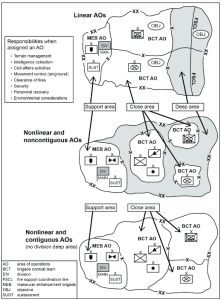
Source: (ADRP 3-0, 2012)
Before discussing Multi-Domain Operations, it is important to note three significant structural and policy changes that directly impact the US interpretation of actions in the space domain and how combat power can be applied. In 2018, President Trump published a National Space Strategy that recognized space as a warfighting domain (Fact Sheets: President Donald J. Trump is Unveiling an America First National Space Strategy, 2018). Many previous administrations acknowledged the need to protect US national security in and from the space domain, but never had a national strategy acknowledged space as a warfighting domain. In 2019, US Space Command was formally re-established, this time as a functional unified combatant command (Lopez, 2019) (Title 10 USC Ch 6: Combatant Commands, n.d.). Finally, the US Space Force was established in 2019 as a service in the US military to organize, train, and equip Guardians (US Space Force, n.d.). Each of these central policy and organizational changes acknowledges the growing criticality of operations in outer space and the threats posed by near-peer competitors such as China and Russia noted earlier in this chapter.
The US Army’s newest operational concept was implemented in 2022 and is now called Multi-Domain Operations (MDO). MDO acknowledges the existence of land, maritime, air, space, and cyberspace and emphasizes Army operations spanning the physical, information, and human dimensions in each of the five domains (See Figure 11-25). MDO also expanded the deep area into the extended deep area, including the operational and strategic deep fires areas depicted in Figures 11-26 and 11-27 (Headquarters Department of the Army, 2022). In practice, MDO elevated the US Army’s primary unit of action from the Brigade to the Division level (See Figures 11-28 and 11-29 for the MDO operational framework and roles of each echelon) and now accounts for the need to provide effects convergence across the spectrum in support of unified action with the joint force. Figures 11-30 to 11-33 graphically depict the concept of effects convergence within the MDO operational framework while Figures 11-34 and 11-35 showcase notional offense and defense scenarios.
Figure 11-25: Domains and Dimensions of an Operational Environment
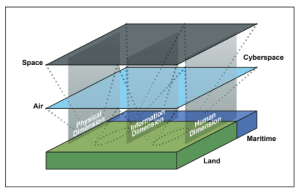
Source: (FM 3-0, 2022)
Figure 11-26: The Multi-Domain Operations Framework
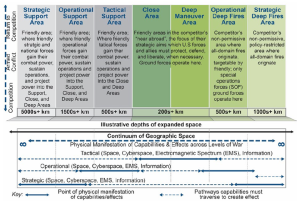
Source: (TP 525-3-1)
Figure 11-27: The Operational Framework in the Context of the Strategic Framework
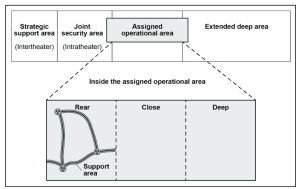
Source: (FM 3-0)
11-28: Notional Corps Deep, Close, and Rear Areas with Contiguous Divisions
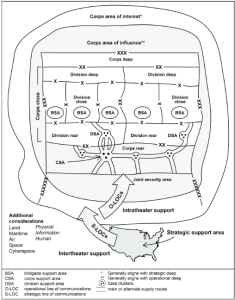
Source: (FM 3-0, 2022)
Figure 11-29: Notional Roles and Responsibilities in Terms of Time, Space, and Purpose at Different Echelons
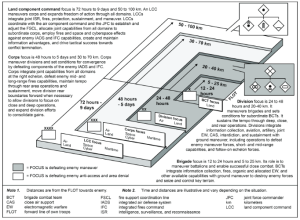
Source: (FM 3-0, 2022)
Figure 11-30: Convergence in Multi-Domain Operations
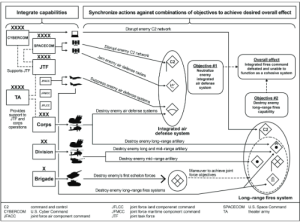
Source: (FM 3-0, 2022)
Figure 11-31: China and Russia in Competition and Armed Conflict Problems Superimposed on the MDO Framework
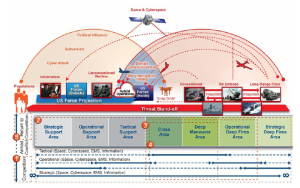
Source: (TP 525-3-1)
Figure 11-32: Convergence Generating Cross-Domain Synergy and Layered Options
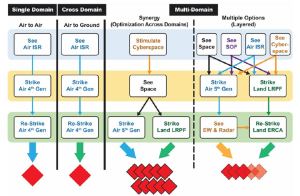
Source: (TP 525-3-1)
Figure 11-33: MDO Solutions
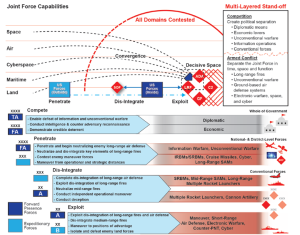
Source: (TP 525-3-1)
Figure 11-34: Notional Enemy Offensive Operation
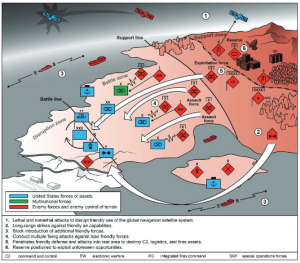
Source: (FM 3-0, 2022)
Figure 11-35: Notional Enemy Maneuver Defense
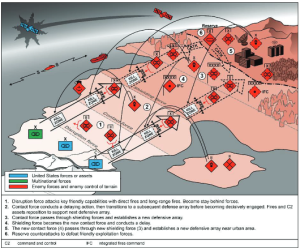
Source: (FM 3-0, 2022)
Thinking back to MDMP as a decision-making framework, the MDO operational concept now requires Army staff officers to model a variety of threats in all five domains, simulate large-scale combat, and compare the results of multiple courses of action. As a result, the space domain cannot remain solely an operational and strategic concern for military planners. With the publication of the US Army’s MDO concept, space modeling and simulations is now a tactical-level responsibility in the wargaming process, requiring a modern solution of toolsets widely proliferated among planners. While sufficient for simulating interactions between ground, air, and maritime order of battle units, the adaptive tabletop wargaming methods may no longer be capable of capturing the complexities of actions in space and cyberspace.
MODELING AND SIMULATION FRAMEWORK
Previously in this chapter, we identified a definition for simulation specific to the Apollo space program use case. Taking a more holistic look at models and simulations across various aerospace use cases, it is helpful to characterize these terms more generally. In a Johns Hopkins APL Technical Digest, James Coolahan defined a model as “a physical, mathematical, or otherwise logical representation of a system, entity, phenomenon, or process” and simulation as “a method for implementing a model over time” (Coolahan, 2003). Models in a space context may account for a single shuttle, a hypersonic missile, or the totality of satellites orbiting Earth with free-floating debris. Similarly, simulations must account for several situations, from a shuttle launch to large-scale combat operations, showing the progression of hundreds of missiles, electronic warfare effects, aircraft, satellites, etc.
There are multiple ways of categorizing models and simulations, but Coolahan’s four viewpoints fit the space use cases described in this chapter. In many cases, models and simulations will have one or more of the following categories and components.
- Application Domain – Captures a specific problem area within a model or simulation, including space physics, a battlefield’s geographic area (potentially in the maritime, air, land, space, and cyber domains), or a transportation network.
- Resolution Level – Identifies the amount of detail and the extent of aggregation within a given model or simulation. As an example, a satellite may have propulsion, actions of maneuvering surfaces, and power generation aggregated together in a single model at a particular level of resolution (See Figure 11-36 for further examples of military and physiological resolution levels).
- Role – The function a specific model or simulation is built to accomplish. An example could be to evaluate a hypersonic missile’s flight performance, analyze a joint firepower strike against multiple satellites, or train a space crew on their duties in the spacecraft.
- Technique – The method a given model or simulation uses to accomplish its purpose. Examples include a static display of a lunar vehicle, a dynamic, constructed environment simulating a space launch, or a model of hardware system components interacting.
Figure 11-37 provides a graphic depiction of Coolahan’s four viewpoints and additional sample characteristics.
Given the threat context and mass proliferation of space-based capabilities described earlier in this chapter, models and simulations must not be constrained to highly technical users. To be successful, models and simulations must be widely used and accepted within the community of interest they support, have a framework that is effective when applied in practice, be available across a large user base, be affordable to the organizations that need it, and be accessible for users to adopt (West & Birkmire, 2020). Models both improve the chances of success for a mission during execution and reduce the overall costs of capability development.
Figure 11-36: Examples of Modeling and Simulation Resolution Levels: (left) Military Simulations and (right) Physiological Models
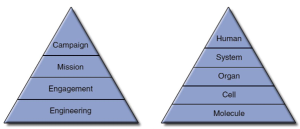
Source: (Johns Hopkins APL Technical Digest, Volume 26, Number 4 | Credit: James Coolahan)
Figure 11-37: A Potential Taxonomy for Models and Simulations Used at APL: Four Views and Sample Characteristics
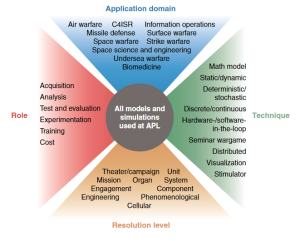
Source: (Johns Hopkins APL Technical Digest, Volume 26, Number 4 | Credit: James Coolahan)
MODELING AND SIMULATION TOOLS
The following list of tools is just a tiny sample of the instruments available for modeling and simulating space effects. Casual gamers may note that there are dozens of realistic space flight simulators on the Steam marketplace as of the publication of this document, many of which are not captured here. DoD employees may also recognize that well-known tools are not included in this list, primarily due to classification and usefulness to an academic audience. There are also customized space simulators, like those developed by NASA for the space shuttle program and SpaceX for commercial purposes, which are proprietary and not publicly available. Nonetheless, this list demonstrates the potential for computer-based modeling today and dozens of use cases for both military and civil purposes.
For an overview of the mechanics (inputs) used to model a spacecraft’s trajectory or satellite’s orbit, please refer to Chapter 10 (Nichols, et al., 2023).
IMPROVED MANY ON MANY (IMOM)
IMOM is a commonly used modeling and simulation tool developed by the Air Force Electronic Warfare Center (AFEWC). This software’s specific purpose is to simulate the routing of an attack aircraft as it penetrates enemy air defense systems, including radars and surface-to-air weapons, providing planners insight into the vulnerability of detection, tracking, and engagement of friendly aircraft along a specific route. Self-protection and stand-off jamming are also critical components of the IMOM simulation. IMOM is customizable to meet user needs and can ingest various classified and unclassified data sets (Ormesher, 1993). Although there are few use cases where IMOM could be used to model activities in the space domain, it provides an example of critical data points to consider in the simulation process for military planners seeking to model aerial flight against a complex enemy air defense (Diebold, 2023).
A combat simulation in IMOM requires a scenario containing an Electronic Order-of-Battle (EOB), terrain mapping, radar, threat, and jammer databases (Ormesher, 1993). The EOB file should provide IMOM with the names and locations of threat radars, weapons, and jammers on Earth’s surface, which can then be modified individually or linked to databases of standardized military equipment (Ormesher, 1993). A sample EOB is depicted in Figure 11-38, further identifying radars with the North Atlantic Treaty Organization (NATO) name, Electronic Intelligence Notation (ELNOT), Personal Identification Number (PIN), and type of radar (further described in the radar database portion of this chapter).
Figure 11-38: Sample EOB Listing
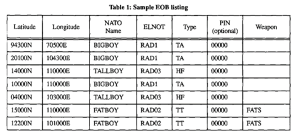
Source: (Richard C. Ormesher )
The terrain file ingested into IMOM typically only captures elevation, but the resolution level in the file is essential to consider (Ormesher, 1993). For example, there are three standardized levels of post spacing when using Digital Terrain Elevation Data (DTED). DTED level 0 has a post spacing of 30 arc seconds (~1km between cells), where DTED level 1 has a post spacing of three arc seconds (~100m), and DTED level 2 is at one arc second (~30m) (VTP, n.d.). The higher the DTED level, the more accurate the line-of-sight analysis. However, there is a tradeoff in simulation time, which takes much longer to complete when using more detailed terrain data (higher levels of DTED) given the additional computation required (Diebold, 2023). Figures 11-39 to 11-41 graphically depict how IMOM calculates line of sight from a radar to an aircraft and how terrain data factors into the output (whether a particular radar can see an aircraft).
Figure 11-39: ROUTE Coordinate System Showing Radar, Line of Sight, Aircraft, and Terrain Profile
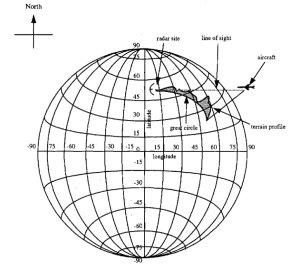
Source: (Richard C. Ormesher)
Figure 11-40: Ground Distance and Azimuth Direction from Radar to Aircraft
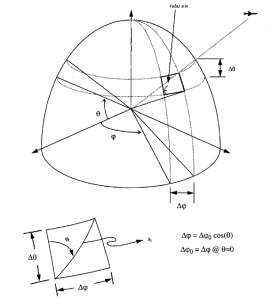
Source: (Richard C. Ormesher)
Figure 11-41: Slant Range and Elevation Angle from Radar to Aircraft
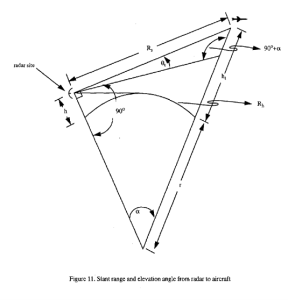
Source: (Richard C. Ormesher)
The radar database file lists parameters to model each specific enemy radar, including power levels, beam widths, antenna gains, and receiver losses. Radars are also characterized by type, with Early Warning (EW) or Target Acquisition (TA) assumed to have vertical beams scanning horizontally and Fire Control (FC), Target Tracking (TT), and Height Finding (HF) assumed to be non-scanning beams pointed at an aircraft (Ormesher, 1993). Figures 11-42 to 11-43 show how IMOM calculates a radar’s beam look angle and range while Figure 11-44 shows how IMOM determines the slant distance from the radar to an aircraft.
Figure 11-42: Diagram Showing Radar Beam Look Angle (in Elevation)
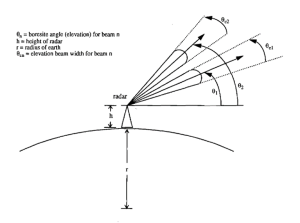
Source: (Richard C. Ormesher)
Figure 11-43: Simple Radar Range Calculation

Source: (Richard C. Ormesher)
Figure 11-44: Slant Distance from Radar to Aircraft Calculation (Credit: Richard C. Ormesher)

Source: (Richard C. Ormesher)
The threat database file lists parameters linked or unlinked to the performance characteristics of weapon systems associated with radar systems (Ormesher, 1993). The primary attributes of a surface-to-air weapon system are the maximum and minimum engagement altitude and the maximum, minimum, and recommended intercept ranges. Although IMOM does not always incorporate seeker types, munition speeds, and their probability of success against specific airframes based on exposure time, this can be considered for windows of vulnerability after a holistic IMOM analysis (Diebold, 2023).
The jammer file simply contains the specific parameters for modeling standardized jammers and their configurations (Ormesher, 1993). Figure 11-45 graphically shows how IMOM models the geometry of a jammer with respect to a radar and aircraft in the simulation. When performing calculations to determine a jammer’s effectiveness, IMOM considers the overlapping frequencies between radar signals and jammer transmitters in addition to geometry.
Figure 11-45: Geometry of Radar, Penetrating Aircraft, and Stand-Off Jammer
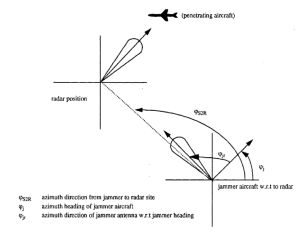
Source: (Richard C. Ormesher)
Beyond the threats and operational environment models, IMOM also models the friendly aircraft and the route it will attempt to fly. When modeling the aircraft, the most important input is the Radar Cross Section (RCS), often measured in decibels (dB) (Diebold, 2023). MIT defines an RCS as the area intercepting that amount of power which, if radiated isotropically, produces the same received power in the radar (See Figure 11-46 for a graphic depiction of RCS). Many factors, including the aircraft’s size, shape, orientation, and materials contribute to its RCS (See Figure 11-47), but the three main contributors are structural, propulsion, and avionics (See Figure 11-48) (MIT Lincoln Laboratory, 2018). IMOM can simplify RCS by applying a constant value (usually the highest value across all aircraft or missile orientations), or it can create a 3D pattern for calculations that will account for the look angle of each radar and the aircraft’s orientation for detection (Ormesher, 1993). The most critical inputs along the aircraft’s route are speed and altitude, which when calculated with position, also allows for orientation to the radar to be factored in (See Figure 11-49 and 11-51). These inputs contribute to how individual radar and weapon systems interpret a friendly aircraft or missile and could impact a threat’s ability to see it all together, even if all other variables in IMOM’s calculations suggest it should be able to. Without external contributing factors (such as a jammer or weather), RCS is the primary variable that friendly forces can influence in a detection decision (See Figure 11-50) (Diebold, 2023).
Figure 11-46: Definition of RCS
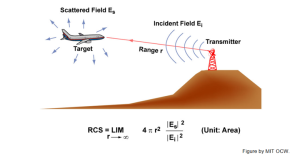
Source: (MIT Lincoln Laboratory)
Figure 11-47: Factors Determining RCS
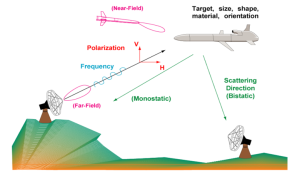
Source: (MIT Lincoln Laboratory)
Figure 11-48: Components of Target RCS
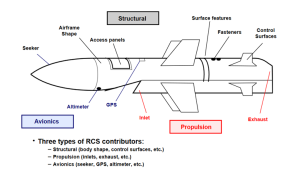
Source: (MIT Lincoln Laboratory)
Figure 11-49: RCS Example
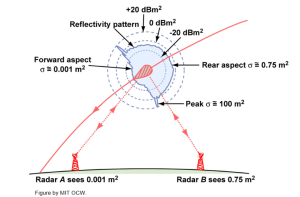
Source: (MIT Lincoln Laboratory)
Figure 11-50: Threat’s View of the Radar Range Equation
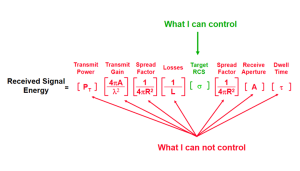
Source: (MIT Lincoln Laboratory)
Figure 11-51: Measured and Calculated RCS of Johnson Generic Aircraft Model
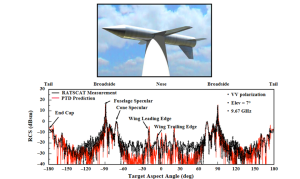
Source: (MIT Lincoln Laboratory)
IMOM’s output is both a graphic display and summary file that indicates the effectiveness of radar (Figure 11-52 depicts the baseline algorithm for determining a radar’s range with respect to aircraft RCS) against an aircraft along its route. The simplest and the most important check that IMOM performs is a comparison of the aircraft, radar, and terrain position and height along a route. This is most comparable to a line-of-sight analysis, which can show if an aircraft is terrain masked effectively while in range of a radar or weapon system. When an aircraft is detected at a specific time and place along the route, IMOM checks the jammer profile to determine whether radar effects should be negated. The user can then compare an aircraft’s position when the vulnerability was identified to the potential weapon systems that could perform an engagement (Ormesher, 1993). Figure 11-54 describes the IMOM ROUTE algorithm in detail, showing how all previously mentioned data sets are incorporated into determining an aircraft’s level of detection (See Figure 11-55) along each point in its flight path.
Figure 11-52: ROUTE Algorithm for Calculating the Radar-Range Equation
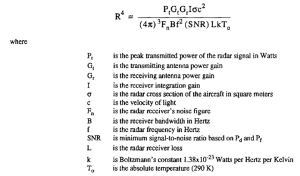
Source: (Richard C. Ormesher)
Figure 11-53: Radar Parameters Used in Radar-Range Equation
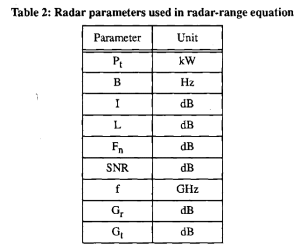
Source: (Richard C. Ormesher)
Figure 11-54: IMOM ROUTE Algorithm Description
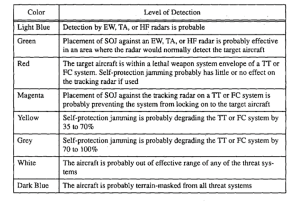
Source: (Richard C. Ormesher)
Figure 11-55: Color Code for Radar Detection
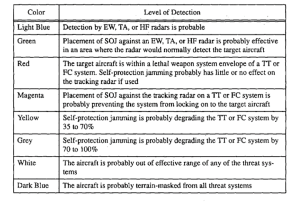
Source: (Richard C. Ormesher)
As mentioned at the beginning of this section, IMOM was not designed for modeling space domain entities. However, the same inputs required to model an aircraft or missile flying in the atmosphere could be extrapolated for other space-centric use cases, such as space electronic warfare or unmanned aircraft satellite communication link analysis (Diebold, 2023) (Drew, 2023).
ADVANCED FRAMEWORK FOR SIMULATION, INTEGRATION, AND MODELING (AFSIM)
AFSIM was created by the Air Force Research Laboratory (AFRL) to make modeling and simulation ubiquitous in the weapon system concept development process, providing a framework for military simulations that seek to analyze, experiment, and wargame. Although developed by the Air Force, AFSIM is a multi-domain toolset capable of modeling land, air, sea, and space-based platforms such as tanks, helicopters, submarines, and satellites. The software also enables users to create their models for implementation if the standard toolkit does not provide the specific entity that a user needs (West & Birkmire, 2020).
AFSIM can model all four resolution levels described by Coolahan, capturing each by complexity and time scale (See Figure 11-57 and 11-58). This allows users to focus on the factors most relevant to the decisions that need to be made from the outcome of the military simulation. For example, at the engagement and engineering levels, a user may be able to answer which satellites a hypersonic missile would need to interact with for positioning, navigation, and timing or communications during an intercontinental flight from launch to impact, factoring in terrain obscuration, jamming effects, and weather. At this level, it may highlight when the communication windows with satellites would be optimal across the flight path or if a satellite needs to push a boosted signal at a specific time and place to achieve an effect. On a larger scale, such as a mission or campaign, AFSIM could highlight the impact of an electronic warfare effect delivered from space on hundreds of units conducting large-scale conflict in a less precise manner (West & Birkmire, 2020).
AFSIM is produced at both the UNCLASSIFIED and SECRET classification levels, with the primary differences being the number, type, and fidelity of the models available for simulation (West & Birkmire, 2020). In the SECRET simulation, approved models for weapon systems and the operational environment are generated from classified intelligence provided by multiple DoD agencies, much like IMOM. For national security, it is common for DoD agencies to protect specific intelligence, such as the performance characteristics of models in AFSIM, to ensure the sources of that information and methods used to collect it remain protected. Therefore, for users with the requisite need to know and clearance to use this information, AFSIM can provide more accurate outputs (Diebold, 2023).
Figure 11-56: AFSIM Application Screenshot
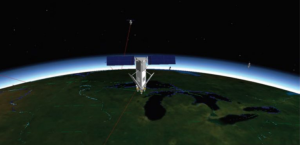
Source: (CSIAC | Credit: Col Timothy West and Brian Birkmire)
Figure 11-57: AFSIM Levels of Wargaming Simulations

Source: (CSIAC | Credit: Col Timothy West and Brian Birkmire)
Figure 11-58: AFSIM Architectural Elements
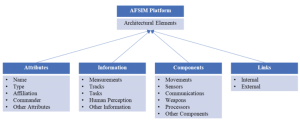
Source: (CSIAC | Credit: Col Timothy West and Brian Birkmire)
EXTENDED AIR DEFENSE SIMULATION (EADSIM)
EADSIM is a system-level simulation developed by the U.S. Army Space and Missile Defense Command (USASMDC) focused on air, space, and missile warfare. EADSIM enables analysts to model performance and predict the effectiveness of ballistic missiles, surface-to-air missiles, aircraft, and cruise missiles for operational-level commanders in multiple environments and scenarios. While AFSIM can simulate all four resolution levels, EADSIM is best suited for the campaign (many on many) and mission levels (few on few). Each system in the simulation is individually modeled to include its command and control, sensors, jammers, networks, flight characteristics, and the effects of terrain and attrition. (U.S. Army Space and Missile Defense Command)
EADSIM has many use cases in the space domain. USASMDC advertises the capability to model and simulate an active defense, passive defense, attack operations, battle management, command, control, communications, and intelligence (BM/C3I), Integrated Air and Missile Defense (IAMD), and Cyber Electromagnetic Activities (CEMA). (U.S. Army Space and Missile Defense Command)
Figure 11-59: EADSIM Application Screenshots
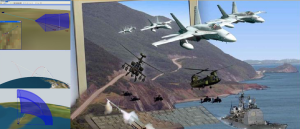
Source: (USASMDC EADSIM Fact Sheet)
GENERAL MISSION ANALYSIS TOOL (GMAT)
GMAT is an open-source space mission analysis tool developed by NASA, private industry, and many individual contributors intended to aid in real-world engineering design studies. Unlike the previous tools, GMAT was not designed specifically for military use cases. Instead, it was built to model, optimize, and estimate spacecraft trajectories in flights ranging from LEO to deep space missions. (GMAT Wiki, n.d.)
GMAT contains resources that can be broken down into physical models and customized to meet user requirements. These include spacecraft, thrusters, tanks, ground stations, formations, impulsive and finite burns, planets, comets, and asteroids. (GMAT Wiki, n.d.)
Figure 11-60: GMAT Project Sample Screenshot
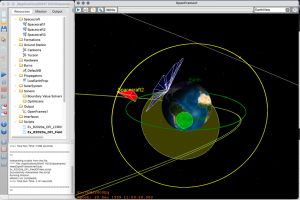
Source: (SOURCEFORGE)
Figure 11-61: Sample GMAT Illustration Using a Low Thrust Propulsion System and Cube-Sat for a Lunar Mission
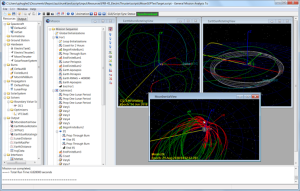
Source: (GMAT Wiki)
SYSTEMS TOOL KIT (STK)
Ansys developed STK to provide a physics-based modeling environment for analyzing platforms and payloads for the aerospace, defense, and telecommunications industries in a realistic mission context. In the premium space version, STK includes advanced orbit design and maneuver planning to improve a user’s understanding of system performance. (Ansys, n.d.)
STK’s capabilities include.
- high-fidelity orbit propagation
- deep space trajectory design
- rendezvous and proximity operations
- conjunction analysis
- orbit maneuver planning
- attitude modeling
- power generation, storage, and consumption modeling
- satellite constellation design
- launch window analysis
- space environment effects
In the space-based systems modeling capabilities, STK has several core programs. The Astrogator assists mission planners in developing, optimizing, and validating flight-ready trajectory solutions for deep space operations. SatPro allows users to model a satellite’s surface area, mass, and solar panel configuration, among other characteristics, to analyze its mission profile strengths and weaknesses. The Space Environment Effects Tool adds variables in the near-Earth space environment to orbit modeling, calculating exposure to ionizing particles, thermal radiation, and space debris. The Conjunction Analysis Tool includes threat analysis to detect potential collisions in space, providing users with a probability of collision, optimal launch windows, and even blackout times when a ground-based laser would affect an object in space. The Analyzer and Optimizer integrates engineering analysis to understand better factors like fuel usage, satellite coverage, and signal-to-noise ratio.
Real-Time Tracking Technology, Distributed Simulation, and Electro-Optical/Infrared (EOIR) models are the most impressive capabilities for military users. These tools allow users to monitor a live simulation in STK and incorporate common data feeds such as Link 16, NATO’s Digital Motion Imagery Standard, and NATO’s Ground Moving Target Indicator Format. EOIR models the detection, tracking, and imaging performance of electro-optical and infrared sensors on satellites, factoring in variables such as atmospheric weather, thermal and optical properties of celestial bodies, and Earth’s surface. (Ansys, n.d.)
Figure 11-62: Sample STK Screenshot Demonstrating Advanced Modeling of Space-Based Platforms and Payloads
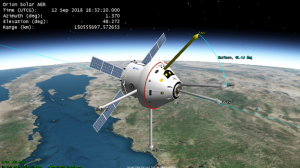
Source: (Ansys STK Premium Space Brochure)
Figure 11-63: Sample STK Screenshot Demonstrating the Space Environment Effects Tool
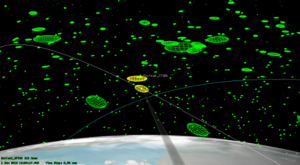
Source: (Ansys STK Premium Space Brochure)
FREEFLYER
AI solutions developed FreeFlyer as a commercial off-the-shelf software application for space mission design, analysis, and operations. Its core functions include spacecraft propagation, coverage and contact analysis, maneuver modeling and targeting, orbit determination, attitude modeling, and terrain analysis. The primary use cases for FreeFlyer include space domain awareness, orbital debris collision avoidance, ground system integration, automated operations, mission design and analysis, wargame strategies, and constellations and clusters. Like AFSIM, the documentation suggests that FreeFlyer has a classified software version for use by government agencies with the appropriate clearance and requirements. (a.i. solutions, n.d.)
Figure 11-64: FreeFlyer Used in the ISS NASA Mission Control Center at Houston, TX
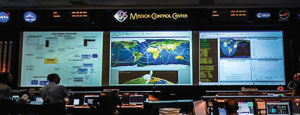
Source: (a.i. solutions FreeFlyer Capabilities Brochure)
Figure 11-65: Sample FreeFlyer Screenshot Demonstrating Analysis of Constellations
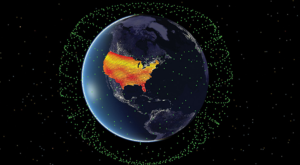
Source: (a.i. solutions FreeFlyer Capabilities Brochure)
CONCLUSIONS
Throughout this chapter, we explored various topics related to space modeling and simulations. In the beginning, this chapter described space operations from the advent of NASA and the first moon landings in 1969 through the modern space environment that now includes thousands of operational satellites from 75 countries. Next, we covered the evolving strategic context through the lens of civilian, commercial, and military space users, especially the growing aerospace defense problem posed by emerging technology. Finally, this chapter examined a framework for models and simulations and the tools and use cases.
More than at any point in history, there is a need for accurate and precise space models and simulations to predict the outcome of any aerospace operation. The space domain has rapidly expanded to impact aspects of civilian life, generated extensive revenue in the commercial sector, and proven to be a warfighting domain extraordinarily relevant to US national security. With the extensive and growing list of tools available, even the average user can learn to take advantage of capabilities in space through an enhanced understanding of complex system interactions. Using this knowledge, we can apply space models and simulations to use cases in any facet of personal life, public service, business, or national defense.
REFERENCES
(Coolahan, 2003) (Goddard Space Flight Center, n.d.) (a.i. solutions, n.d.) (U.S. Army Space and Missile Defense Command)
a.i. solutions. (n.d.). FreeFlyer Astrodynamics Software. Retrieved from a.i. solutions: https://ai-solutions.com/freeflyer-astrodynamic-software/
Ansys. (n.d.). Ansys Systems Tool Kit (STK) – Software for Digital Mission Engineering and Systems Analysis. Retrieved from https://www.ansys.com/products/missions/ansys-stk
Arms Control Association. (2022, November). Seven Countries Join ASAT Test Ban. Retrieved from Arms Control Association: https://www.armscontrol.org/act/2022-11/news-briefs/seven-countries-join-asat-test-ban
Badham, J. (Director). (1983). WarGames [Motion Picture].
Balachandran, A., Rabuya, L. C., Shinde, S., & Takalkar, A. (n.d.). Simulation and Modeling Team. Retrieved from University of Houston: https://uh.edu/~lcr3600/simulation/contents.html
Blatt, T. M. (2020, May 26). Anti-Satellite Weapons and the Emerging Space Arms Race. Retrieved from Harvard International Review: https://hir.harvard.edu/anti-satellite-weapons-and-the-emerging-space-arms-race/
Brockmann, K., & Schiller, M. (2022, February 4). A matter of speed? Understanding hypersonic missile systems. Retrieved from Stockholm International Peace Research Institute: https://sipri.org/commentary/topical-backgrounder/2022/matter-speed-understanding-hypersonic-missile-systems
Bugos, S. (2021, December). Russian ASAT Test Creates Massive Debris. Retrieved from Arms Control Association: https://www.armscontrol.org/act/2021-12/news/russian-asat-test-creates-massive-debris
Caffrey, M. (2000, April 27). Toward a History Based Doctrine for Wargaming. Retrieved from Air University: https://www.airuniversity.af.edu/Portals/10/ASPJ/journals/Chronicles/caffrey.pdf
Chakrabarti, S. (2021, September 25). How many satellites are orbiting Earth? Retrieved from space.com: https://www.space.com/how-many-satellites-are-orbiting-earth
Clausewitz, C. v. (n.d.). On War.
Congressional Research Service. (2023, February 13). Hypersonic Weapons: Background and Issues for Congress (R45811). Retrieved from https://sgp.fas.org/crs/weapons/R45811.pdf
Congressional Research Service. (2023, March 16). The Army’s Multi-Domain Task Force (MDTF). Retrieved from congress.gov: https://crsreports.congress.gov/product/pdf/IF/IF11797
Coolahan, J. E. (2003). Modeling and Simulation at APL. Johns Hopkins APL Technical Digest, Volume 24, Number 1.
CSIS. (2023, February 16). Space Environment: Total Launches by Country. Retrieved from CSIS Aerospace: https://aerospace.csis.org/data/space-environment-total-launches-by-country/
CSIS Missile Defense Project. (2021, August 2). Minuteman III. Retrieved from Missile Threat: https://missilethreat.csis.org/missile/minuteman-iii/
CSIS Missile Defense Project. (2021, April 12). Missiles of China. Retrieved from https://missilethreat.csis.org/country/china/
CSIS Missile Defense Project. (2021, August 10). Missiles of Russia. Retrieved from https://missilethreat.csis.org/country/russia/
CSIS Missile Defense Project. (2023, February 28). Tomahawk. Retrieved from Missile Threat: https://missilethreat.csis.org/missile/tomahawk/
David, L. (2021, April 14). Space Junk Removal Is Not Going Smoothly. Retrieved from Scientific American: https://www.scientificamerican.com/article/space-junk-removal-is-not-going-smoothly/
Diebold, C. (2023). Author’s Personal Experience.
Drew, J. (2023, May 1). (C. Diebold, Interviewer)
Eckstein, M. (2017, April 7). How the U.S. Planned and Executed the Tomahawk Strike Against Syria. Retrieved from USNI News: https://news.usni.org/2017/04/07/us-planned-executed-tomahawk-strike
ESRI. (2022, January). SatteliteXplorer. Retrieved from ESRI: https://geoxc-apps.bd.esri.com/space/satellite-explorer/
(2018). Fact Sheets: President Donald J. Trump is Unveiling an America First National Space Strategy.
FCNL Education Fund. (2021, March). Intercontinental Ballistic Missiles (ICBMs) Increase the Risk of Nuclear War. Retrieved from https://www.fcnl.org/sites/default/files/2021-03/ICBMs%20Increase%20the%20Risk%20of%20Nuclear.FINAL_.pdf
Freedberg, S. J. (2019, June 4). Army Wants Hypersonic Missile Unit by 2023: Lt. Gen. Thurgood. Retrieved from breakingdefense.com: https://breakingdefense.com/2019/06/army-wants-hypersonic-missile-unit-by-2023-lt-gen-thurgood/
GAO. (2022, June). Missile Defense – Better Oversight and Coordination Needed for Counter-Hypersonic Development (GAO-22-105075). Retrieved from gao.gov: https://www.gao.gov/assets/gao-22-105075.pdf
GMAT Wiki. (n.d.). GMAT Wiki. Retrieved from Confluence: https://gmat.atlassian.net/wiki/spaces/GW/overview
Goddard Space Flight Center. (n.d.). Design and Integration Tools – General Mission Analysis Tool (GMAT) v.R2016a. Retrieved from NASA TECHNOLOGY TRANSFER PROGRAM: https://software.nasa.gov/software/GSC-17177-1
Graham-Harrison, E. (2017, April 7). A visual guide to the US missile strikes on a Syrian airbase. Retrieved from The Guardian: https://www.theguardian.com/world/2017/apr/07/visual-guide-us-airstrikes-on-syria-donald-trump
Granai, C. (2015, January 3). “A Complex and Volatile Environment”: The Doctrinal Evolution from Full Spectrum Operations to Unified Land Operations. Retrieved from https://apps.dtic.mil/sti/pdfs/AD1001386.pdf
Hadley, G. (2023, January 13). Saltzman: China’s ASAT Test Was ‘Pivot Point’ in Space Operations. Retrieved from Air & Space Forces Magazine: https://www.airandspaceforces.com/saltzman-chinas-asat-test-was-pivot-point-in-space-operations/
Headquarters Department of the Army. (2001, June). FM 3-0 Operations. Retrieved from https://www.bits.de/NRANEU/others/amd-us-archive/fm3-0%2801%29.pdf
Headquarters Department of the Army. (2011, October). ADP 3-0 Unified Land Operations. Retrieved from https://www.army.mil/e2/downloads/rv7/info/references/ADP_3-0_ULO_Oct_2011_APD.pdf
Headquarters Department of the Army. (2012, May). ADRP 3-0 Unified Land Operations. Retrieved from https://www.lsu.edu/hss/milsci/resources/adrp3_0.pdf
Headquarters Department of the Army. (2022, October). FM 3-0 Operations. Retrieved from https://irp.fas.org/doddir/army/fm3-0.pdf
Heginbotham, E., Nixon, M., Morgan, F. E., Heim, J. J., Hagen, J., Li, S., . . . Morris, L. J. (n.d.). The U.S.-China Military Scorecard – Forces, Geography, and the Evolving Balance of Power 1996-2017. Retrieved from RAND Corporation: https://www.rand.org/paf/projects/us-china-scorecard.html
History.com Editors. (2009, November 18). Bombing of Hiroshima and Nagasaki. Retrieved from History.com: https://www.history.com/topics/world-war-ii/bombing-of-hiroshima-and-nagasaki
History.com Editors. (2022, November 9). Atomic Bomb History. Retrieved from History.com: https://www.history.com/topics/world-war-ii/atomic-bomb-history#:~:text=The%20atomic%20bomb%20and%20nuclear%20bombs%20are%20powerful,of%20World%20War%20II%2C%20in%20Hiroshima%20and%20Nagasaki.
Howell, E. (2021, October 3). SpaceX’s Inspiration4 all-civilian spaceflight: Here’s what to know. Retrieved from space.com: https://www.space.com/spacex-inspiration4-mission-explained
International Trade Administration. (n.d.). Market Overview – Space Launch. Retrieved from Commercial Space: https://www.trade.gov/commercial-space
Joint Chiefs of Staff. (n.d.). Origin of Joint Concepts. Retrieved from https://www.jcs.mil/About/Origin-of-Joint-Concepts/
Jomini, A. H. (n.d.). The Art of War.
Judson, J. (2021, October 7). ‘Dark Eagle’ has landed: US Army finishes equipping first unit with hypersonic capability — minus the missiles. Retrieved from DefenseNews: https://www.defensenews.com/breaking-news/2021/10/07/dark-eagle-has-landed-us-army-finishes-equipping-first-unit-with-hypersonic-capability-minus-the-missiles/
Kim, S. E. (2021, August 25). Can the World’s First Space Sweeper Make a Dent in Orbiting Debris? Retrieved from Smithsonian Magazine: https://www.smithsonianmag.com/science-nature/can-worlds-first-space-sweeper-make-dent-orbiting-debris-180978515/
Lopez, C. T. (2019, September 27). Spacecom Built for Today’s Strategic Environment. Retrieved from U.S. Department of Defense: https://www.defense.gov/News/News-Stories/Article/Article/1973953/spacecom-built-for-todays-strategic-environment/
Missile Defense Advocacy Alliance. (2023, January). China. Retrieved from https://missiledefenseadvocacy.org/missile-threat-and-proliferation/todays-missile-threat/china/
Missile Defense Advocacy Alliance. (n.d.). Russia. Retrieved from https://missiledefenseadvocacy.org/missile-threat-and-proliferation/todays-missile-threat/russia/
MIT Lincoln Laboratory. (2018). Introduction to Radar Systems – Target Radar Cross Section. Retrieved from https://www.ll.mit.edu/sites/default/files/outreach/doc/2018-07/lecture%204.pdf
NASA. (2000, January 19). NASA JOHNSON SPACE CENTER ORAL HISTORY PROJECT – BIOGRAPHICAL DATA SHEET – Carroll H. “Pete” Woodling. Retrieved from NASA: https://historycollection.jsc.nasa.gov/JSCHistoryPortal/history/oral_histories/WoodlingCH/CHW_BIO.pdf
NASA. (2009, September 4). Three Classes of Orbit. Retrieved from NASA Earth Observatory: https://earthobservatory.nasa.gov/features/OrbitsCatalog/page2.php
NASA. (2018, April 2). NASA History Overview. Retrieved from NASA: https://www.nasa.gov/content/nasa-history-overview
National Air and Space Museum. (2017, May 23). Ask an Explainer. Retrieved from How Things Fly: https://howthingsfly.si.edu/ask-an-explainer/what-speed-required-launch-object-space
Neuman, S. (2023, March 9). Russia is firing hypersonic missiles into Ukraine that are nearly impossible to stop. Retrieved from npr.org: https://www.npr.org/2023/03/09/1162185287/hypersonic-missiles-ukraine-russia
Nichols, R., Carter, C., Diebold, C., Drew, J., Farcot, M., Jackson, M., . . . & Toebes, J. (2023). Space Electronic Warfare. In R. Nichols, CYBER HUMAN SYSTEMS, SPACE TECHNOLOGIES AND THREATS (p. Chapter 10). Manhattan: New Prairie Press. Accepted for Publication, 2023; NPP#TBN.
Olivier, S. S. (2008, September 15). A Simulation and Modeling Framework for Space Situational Awareness. Retrieved from https://www.osti.gov/servlets/purl/945663
Ormesher, R. C. (1993, April). Improved Many-On-Many ROUTE Software Description. Retrieved from National Technical Information Service: https://ntrl.ntis.gov/NTRL/dashboard/searchResults/titleDetail/DE93013961.xhtml
P., N. R. (2014, July 1). The World’s first guided missiles : V1 and V2. Retrieved from defencyclopedia: https://defencyclopedia.com/2014/07/01/the-worlds-first-guided-missiles-v1-and-v2/#:~:text=The%20V1%20has%20the%20distinction%20of%20being%20the,and%20flew%20at%20a%20speed%20of%20640%20km%2Fhr.
Page, E. H. (n.d.). Modeling and Simulation, Experimentation, and Wargaming – Assessing a Common Landscape. Retrieved from https://www.mitre.org/sites/default/files/publications/16-2757-modeling-and-simulation-experimentation-and-wargaming.pdf
Panda, A., & Silverstein, B. (2022, April 20). The U.S. Moratorium on Anti-Satellite Missile Tests Is a Welcome Shift in Space Policy. Retrieved from Carnegie Endowment for International Peace: https://carnegieendowment.org/2022/04/20/u.s.-moratorium-on-anti-satellite-missile-tests-is-welcome-shift-in-space-policy-pub-86943
Precedence Research. (n.d.). Simulation Software Market. Retrieved from https://www.precedenceresearch.com/simulation-software-market
Skibba, R. (2021, November 17). The US Space Force Wants to Clean Up Junk in Orbit. Retrieved from Wired: https://www.wired.com/story/the-us-space-force-wants-to-clean-up-junk-in-orbit/
Skinner, D. W. (1988, September). Airland Battle Doctrine. Retrieved from https://apps.dtic.mil/sti/pdfs/ADA202888.pdf
Smith, M. (2022, August 10). Anti-satellite weapons: History, types and purpose. Retrieved from space.com: https://www.space.com/anti-satellite-weapons-asats
SOURCEFORGE. (2023, January 26). General Mission Analysis Tool (GMAT). Retrieved from sourceforge.net: https://sourceforge.net/projects/gmat/
Staff. (2023). Oxford Dictionary. London: Oxford Dictionary.
Tate, K. (2021, November 3). How Intercontinental Ballistic Missiles Work (Infographic). Retrieved from Space.com: https://www.space.com/19601-how-intercontinental-ballistic-missiles-work-infographic.html
Tchorowski, N., Murawski, R., Manning, R., & Fuentes, M. (n.d.). Modeling and Simulation of Phased Array Antennas to Support Next-Generation Satellite Design.
Tellis, A. J. (2019, April 15). India’s ASAT Test: An Incomplete Success. Retrieved from Carnegie Endowment for International Peace: https://carnegieendowment.org/2019/04/15/india-s-asat-test-incomplete-success-pub-78884
The Editors of Encyclopedia Britannica. (2023, March 28). Cruise Missile. Retrieved from Britannica: https://www.britannica.com/technology/cruise-missile
The Editors of Encyclopedia Britannica. (n.d.). go. Retrieved from https://www.britannica.com/topic/go-game
The International Institute for Strategic Studies. (2022, February). China’s 2021 orbital-weapon tests. Retrieved from IISS.org: https://www.iiss.org/publications/strategic-comments/2022/chinas-2021-orbital-weapon-tests#:~:text=In%20mid-2021%2C%20China%20launched%20two%20unprecedented%20test%20weapons,the%20atmosphere%2C%20which%20hit%20targets%20on%20Chinese%20territory.
Tingley, B. (2022, December 12). US Air Force launches 1st operational hypersonic missile. Retrieved from space.com: https://www.space.com/us-air-force-launches-first-hypersonic-missile
Title 10 USC Ch 6: Combatant Commands. (n.d.). Retrieved from https://uscode.house.gov/view.xhtml?path=/prelim@title10/subtitleA/part1/chapter6&edition=prelim
Tzu, S. (n.d.). The Art of War.
U.S. Army Space and Missile Defense Command. (n.d.). Extended Air Defense Simulation (EADSIM). Retrieved from https://www.smdc.army.mil/Portals/38/Documents/Publications/Fact_Sheets/EADSIM.pdf
University of Florida Department of Mechanical & Aerospace Engineering. (n.d.). History of Cruise Missiles. Retrieved from https://mae.ufl.edu/~uhk/CRUISE-MISSILES.pdf
US Army Training and Doctrine Command. (2018, December 6). TP 525-3-1 The U.S. Army in Multi-Domain Operations 2028. Retrieved from https://adminpubs.tradoc.army.mil/pamphlets/TP525-3-1.pdf
US Space Force. (n.d.). United States Space Force History. Retrieved from https://www.spaceforce.mil/About-Us/About-Space-Force/History/
VTP. (n.d.). DTED files (Digital Terrain Elevation Data). Retrieved from http://vterrain.org/Elevation/dted.html
Wampler, R. L., Centric, J., & Salter, M. S. (1998, January). The Military Decision-Making Process (MDMP): A Prototype Training Product. Retrieved from U.S. Army Research Institute for the Behavioral and Social Sciences: https://apps.dtic.mil/sti/pdfs/ADA343154.pdf
Watts, J. T., Trotti, C., & Massa, M. J. (2020, August). Primer of Hypersonic Weapons in the Indo-Pacific Region. Retrieved from Atlantic Council Scowcroft Center for Strategy and Security: https://www.atlanticcouncil.org/wp-content/uploads/2020/08/Hypersonics-Weapons-Primer-Report.pdf
Wellerstein, A. (2022). Nukemap 2.72. Retrieved from nuclearsecrecy.com: https://nuclearsecrecy.com/nukemap/
West, T. D., & Birkmire, B. (2020, January 9). AFSIM: The Air Force Research Laboratory’s Approach to Making M&S Ubiquitous in the Weapon System Concept Development Process. Retrieved from Cybersecurity & Information Systems Information Analysis Center: https://csiac.org/articles/afsim-the-air-force-research-laboratorys-approach-to-making-ms-ubiquitous-in-the-weapon-system-concept-development-process/
Woodling, C., Faber, S., Van Bockel, J. J., Olasky, C. C., Williams, W. K., Mire, J. L., & Homer, J. R. (1973, March). Apollo Experience Report – Simulation of Manned Space Flight for Crew Training. Retrieved from NASA: https://www.hq.nasa.gov/alsj/tnD7112Simulators.html
ENDNOTES
[1] Operational variables refer to the PMESII acronym in joint US military doctrine including Political, Military, Economic, Social, Information, and Infrastructure. The mission variables refer to the acronym METT-TC including Mission, Enemy, Terrain, Troops Available (extrapolated to mean resources), Time, and Civilian Considerations.
[2] Translated: “A glance that takes in a comprehensive view.” (Staff, 2023)
[3] DoD and Open-Source documentation varies on the advertised capabilities of the Tomahawk, likely due to the numerous variants.

